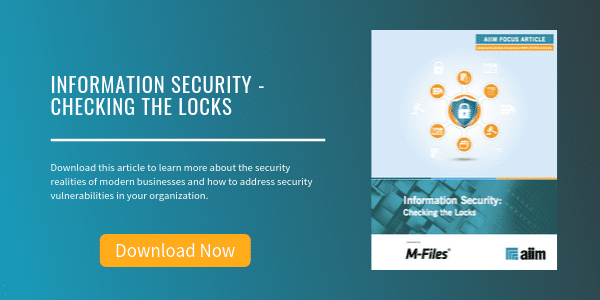
Four Safeguards You Can Take to Protect Your Information
Capture and Imaging | Information Security
A typical document imaging system is creating four major vulnerabilities that substantially increase the potential for data theft and violations of information management regulations:
- Not encrypting the data while it's in motion.
- Unsecured log files.
- Poor visibility into operator activities.
- Poor security management.
New technology can help mitigate the above risks. I'm not here to sell you a system, I'm here to sell you an approach to a system. I'm telling you that if you're sitting on years old document scanning system, you're probably at risk, and it's time for you to look for a system. Get out your legal pad. Get out your pen and get ready to write down the four things I'm about to tell you to look for in a new document scanning system.
1. Impersonation
The first safeguard is “impersonation.” No, no. Don't start belting out Elvis tunes. What you want is a system that writes data to a different user account than the one used by the scanner operator -- no more having the fox mind the chicken coop. You want to eliminate access to the network files, and you want to ensure that operators can only access images through the capture platform. This keeps them from looking at things they shouldn't be looking at and doing anything with the images and data that they shouldn't be doing.
2. Protect Your Images and Data
The second safeguard is to look for systems that protect imaging data. You want to look for strong encryption algorithms. Don't believe those that say, "Oh, you don't want to encrypt things, it'll slow your systems down." That is ten-year-old thinking. You need strong encryption algorithms that automatically protect all data stored on all hard drives and PCs, and it won't impact your system performance.
In this kind of environment, your users can access data via an authentication device. It might be a password, and it might be a key. This enables the system to retrieve the information and decrypt it. Of course, your IT and your security folks can help you select and manage exactly what kind of full disk encryption technology is used. The key thing is you want to make sure that you have a scanning solution that supports full disk encryption.
You want to look for a document imaging system that uses Internet Protocol Security (IPSec) tunnels to encrypt data and images that are in motion. This is basically a framework of open standards that the propeller heads have come up with to help ensure private, secure communications over IP networks. It uses cryptographic security services. This hardened security will keep information in motion safe and supports network-level data integrity. It also supports data confidentiality and authenticates data. It makes sure that folks can't intercept your information.
Here again, your IT and your security staff can work with your vendor to configure IPSec based on your organization's requirements and needs. The key thing is you want to make sure that you have a document scanning solution that supports IPSec. You don't want to write sensitive information to a hard drive of a host PC. That makes no sense. If your solution is doing this, you need to look for a new system that will only write it into memory and not to a host PC that somebody can gain access to.
3. Secure Your Audit Logging Processes
The third safeguard is audit logging. Audit logging is a really good way to monitor the health and operation of a document scanning system. Yet, it's really overlooked when it comes to security. When you look for a document scanning solution, look for one that supports a detailed audit. You want to track every activity that occurs within the software and the hardware. This includes things like changes to admin passwords and anything that might have been faxed or emailed or downloaded.
If your auditors haven't told you this already, log files are also critical for regulatory compliance. It's something that auditors expect and obviously something for which they are looking. You want to make sure that batch log files are written directly to a network and not to a local drive. Finally, when it comes to audit logging, make sure that any sensitive information is sanitized in the log file. Today's document scanning solutions can sanitize information so that nothing is left out in the open.
4. Strong Security Management
The fourth safeguard in a document scanning solution is strong security management. You should be able to do this yourself. You should be able to do it yourself with the security control panel. Dashboards should provide easy control of configuration. This makes it easy for your administrators to review security settings to help change them based on the needs of the business. It saves them a lot of time for network administrators as well as for IT professionals. It's easy to change the configurations.
About Mark Brousseau
Mark Brousseau is a noted marketer, analyst, speaker, and writer with more than twenty years of experience advising leading providers of payments and document automation solutions. He is President of Brousseau and Associates, a full-service marketing PR and business development firm specializing in the payments and document automation arenas.



